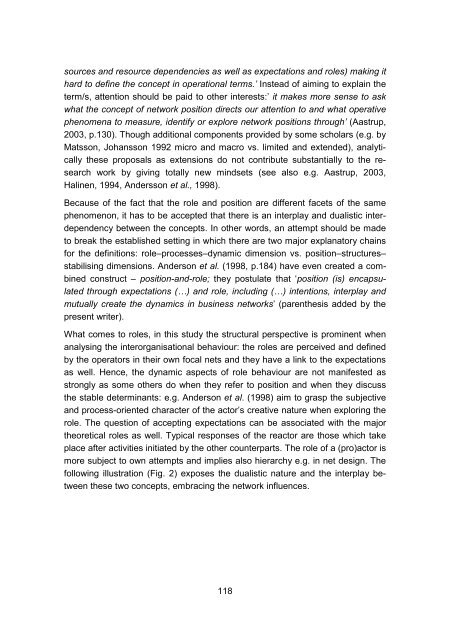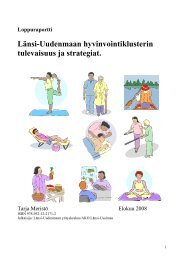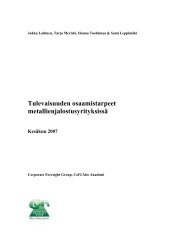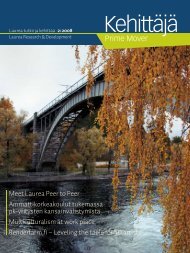849954 sisus
849954 sisus
849954 sisus
Create successful ePaper yourself
Turn your PDF publications into a flip-book with our unique Google optimized e-Paper software.
sources and resource dependencies as well as expectations and roles) making it<br />
hard to define the concept in operational terms.’ Instead of aiming to explain the<br />
term/s, attention should be paid to other interests:’ it makes more sense to ask<br />
what the concept of network position directs our attention to and what operative<br />
phenomena to measure, identify or explore network positions through’ (Aastrup,<br />
2003, p.130). Though additional components provided by some scholars (e.g. by<br />
Matsson, Johansson 1992 micro and macro vs. limited and extended), analytically<br />
these proposals as extensions do not contribute substantially to the research<br />
work by giving totally new mindsets (see also e.g. Aastrup, 2003,<br />
Halinen, 1994, Andersson et al., 1998).<br />
Because of the fact that the role and position are different facets of the same<br />
phenomenon, it has to be accepted that there is an interplay and dualistic interdependency<br />
between the concepts. In other words, an attempt should be made<br />
to break the established setting in which there are two major explanatory chains<br />
for the definitions: role–processes–dynamic dimension vs. position–structures–<br />
stabilising dimensions. Anderson et al. (1998, p.184) have even created a combined<br />
construct – position-and-role; they postulate that ‘position (is) encapsulated<br />
through expectations (…) and role, including (…) intentions, interplay and<br />
mutually create the dynamics in business networks’ (parenthesis added by the<br />
present writer).<br />
What comes to roles, in this study the structural perspective is prominent when<br />
analysing the interorganisational behaviour: the roles are perceived and defined<br />
by the operators in their own focal nets and they have a link to the expectations<br />
as well. Hence, the dynamic aspects of role behaviour are not manifested as<br />
strongly as some others do when they refer to position and when they discuss<br />
the stable determinants: e.g. Anderson et al. (1998) aim to grasp the subjective<br />
and process-oriented character of the actor’s creative nature when exploring the<br />
role. The question of accepting expectations can be associated with the major<br />
theoretical roles as well. Typical responses of the reactor are those which take<br />
place after activities initiated by the other counterparts. The role of a (pro)actor is<br />
more subject to own attempts and implies also hierarchy e.g. in net design. The<br />
following illustration (Fig. 2) exposes the dualistic nature and the interplay between<br />
these two concepts, embracing the network influences.<br />
118








